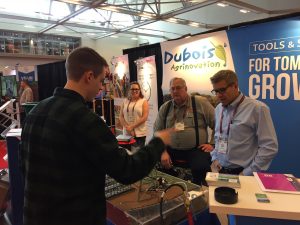
Irrigate efficiently at the right time and the right place
Source: The Grower
The majority of requests to a plant doctor – 80 per cent — are water-related. Not insects or disease but water! One of California’s foremost experts on irrigation efficiency shared this statistic with tender fruit growers at the Ontario Fruit and Vegetable Convention.
“When there’s a historic drought and resources are scarce, farmers are prompted to do a better job,” says Inge Bisconer, Technical Marketing and Sales Manager for The Toro Company.
“In California, we’ve improved irrigation efficiency in the last two decades. Two- thirds of all drip irrigation in the U.S. happens in California. And the result is better quality produce.”

Moving to drip irrigation is an expensive proposition for tree fruit growers. She explained that the root zone is generally 24 inches deep but 80 to 90 per cent of the feeder roots are in the top foot of soil where most of the moisture is extracted. She’s a fan of drip irrigation which does a good job of feeding feeder roots. Micro-irrigation should wet 25 to 60 per cent of the root zone.
To set up an effective system, make sure you employ the experts for good design.
Equipment selection and choosing the right drip tape are key to irrigation efficiency.
Regardless of the terrain, soil conditions and irregular-sized fields, it’s important to custom design a system that will factor in these variables.
“A good design will ensure that the sub-mains will feed properly into the laterals,” says Bisconer. “But to be honest, irrigation scheduling is the art.”
“Water is free from the sky but labor is expensive, so reducing labor inputs is critical,” she says. “The bottom line is that farmers are blaming the regulators for their water headaches, but once they get through the pains of better water management through technology, they make more money.”
“The bottom line is that farmers are blaming the regulators for their water headaches, but once they get through the pains of better water management through technology, they make more money.”
Once you adopt drip irrigation, you become more knowledgeable about the crop growth curve and more sensitive to the exact times when water is needed.
 Maintenance of drip irrigation systems tends to be forgotten but is equally important. Small passageways may get clogged with organic material. It’s key to flush these particles out for top performance.
Maintenance of drip irrigation systems tends to be forgotten but is equally important. Small passageways may get clogged with organic material. It’s key to flush these particles out for top performance.
“You have to manage the system like a hot tub – the system needs cleaning,” she says.
In the future, look for the irrigation results from the Kearney Agricultural Research and Extension folks at the University of California. They are comparing conventional height peach trees with pedestrian height (six to seven feet) trees at four to eight-foot spacings using UC-developed size-reducing rootstocks. They are comparing conventional micro-sprinkler irrigation of conventional height trees versus subsurface drip irrigation in the pedestrian trees.
Article by Karen Davidson via The Grower




